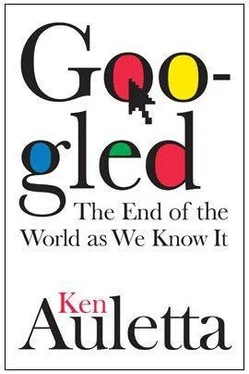GOOGLE WAS NOT IMMUNE to the downturn. Signs of the downturn were apparent on Google search. During the fall, travel was no longer among the most popular search words or phrases, but home safes was; by early 2009, searches for bankruptcy had jumped 52 percent. The “most significant thing that happened at Google” in the past six months, Bill Campbell said in November 2008, “was the realization that there was a flattening of the business.” This realization, he said, was driven by Schmidt, who began reviewing “expenses relative to revenue every Monday.” Another senior executive at Google credited not Schmidt but the new senior vice president and chief financial officer, Patrick Pichette, “for forcing, for the first time, the company to focus on priorities” and to “allocate capital based on whether there are returns.” The founders’ push to expand into a multitude of businesses was, for the first time, subjected to a budget analysis and scaled back, this executive said. “While Google’s success is hard to dispute, I don’t think they are a particularly well-managed company,” Mary Meeker said. “Part of the problem was that Larry and Sergey didn’t need to care about the numbers because growth was so steady and the company’s competitive position was so strong they didn’t feel they had to. The downturn in the economy gave the new CFO help in imposing some cost discipline.”
Pichette had come over from Canada’s foremost telephone company, Bell Canada, where he was credited with slashing two billion dollars from its operating costs. A thin man of modest height, he comes to work lugging a backpack and wearing jeans, a button-down shirt with sleeves rolled up, and a ready smile. Told that he has come to Google at a bad time, he quickly disagrees. “You can argue that I came at a good time,” he said. “When everything runs well and works perfectly, at least according to financial results, you don’t take the time to ask tougher questions because you don’t have to. When you’re growing so fast that you’re running out of desks, if you talked to people about waste and inefficiencies they wouldn’t have listened to you. It would have been the wrong question to ask at that time.”
In a March 2009 Morgan Stanley conference interview with Mary Meeker, Eric Schmidt said, “Patrick is particularly good at business reviews, so we’ve been going through systematically business after business. In our hypergrowth period, we did not have the necessary systems in place…” Pichette was well rewarded; he received a bonus for 2008 of $1.2 million, though he had only worked six months; it was the highest bonus granted by Google. (Schmidt and the founders, as is their custom, take no bonus.) For the first time, Google was contracting. It slowed its hiring, adding only 99 employees in the fourth quarter of 2008, fewer than it added in a week at the start of the year, bringing its employment total at the end of 2008 to 20,222. It laid off some of its 10,000 outside contract workers, sliced 300 jobs at DoubleClick, reduced by one-quarter its 400 job recruiters, and scaled back some of its engineering teams. Taking a closer look at management, Google decided that management was not Dr. Larry Brilliant’s forte, and gave him a new title as chief philanthropic evangelist, replacing him with Megan Smith, who would retain her position as vice president for new business development. It delayed the opening of its Oklahoma data center by eighteen months, and closed its office outside Phoenix, which had two dozen full-time employees. After Pichette discovered that in some cafeterias-most buildings have one-a third of the food was thrown out at the end of each day, cafeteria hours were reduced and menus pared. Google also curbed some free services and, according to a longtime executive, engaged in a “hot debate” over whether to continue to offer water in plastic bottles or switch to less expensive filtered tap water. (By 2009, Google was serving filtered water out of plastic cups, which were soon to be replaced by reusable and renewable cups.)
Google also eliminated a few sites, including Lively, its virtual world, and began to welcome ads on such formerly ad-free sites as Google Finance and Google News. Although Tim Armstrong boasted in September that Google Print Ads had “70 percent of newspapers in the U.S. as clients,” the program had been encountering resistance from newspapers reluctant to cede control of big clients or sales staffs; as a result, it wound up selling mostly remnant ads, and often for below-market rates. Just months after Armstrong’s announcement, the program was terminated. In its day-care program, Google jacked up both the level of services and the cost-from $1,425 per month to $2,500, reported Joe Nocera of the New York Times. This elite offering-and its elitist price-seemed at variance with Google’s egalitarian ideals, and many employees were irate.
These cuts probably displeased two Google audiences, one external, the other internal. For talented young engineers, who look to join companies that are rockets, Google’s actions might suggest a company that had reached cruising speed and might be descending. And as Google coped for the first time with saying no, there was frustration among Google employees accustomed to hearing yes. The founders had sold Google’s mission as making the world a better place, not just making money. While the Google rocket soared, hard choices could be avoided; now they would have to be made.
Soon after Google shuttered its office outside Phoenix, the closing was raised at the September 19, 2008, TGIF session. The complaint came in a text message from an employee in London, which Brin read aloud to the assembled Googlers. It said, “What of people in Phoenix who can’t relocate? If we don’t take care of them, shame on us as a company!” Brin allowed Alan Eustace, senior vice president, engineering and research, to answer. Google, he said, would strive to find openings for those wishing to relocate; for the others, Phoenix was “a robust area for jobs.” Brin and Page said nothing, but associates said they were increasingly distressed by Google employees’ sense of entitlement. This was a company, not a socialist paradise, and the Phoenix question-like the grumbling when Google pared cafeteria hours and no longer allowed employees to cart home dinners for the entire family-troubled them.
With a cash hoard of $14 billion, Google was better positioned than most companies to withstand the economic shocks, but this did not stop its stock from plunging from nearly $700 per share at the start of 2008 to $307 at the end. The value of Brin’s and Page’s stock holdings reduced their net worth to about $12 billion each, which they said did not faze them. Although the downturn hit most media companies hard, online advertising continued to rise. Google now claimed 40 percent of all online ads. Revenues and profits climbed more slowly, though, and the company warned in its year-end 2008 filing to the FCC, “We believe our revenue growth rate will generally decline” as the search market matures.
Despite the downturn and its own difficulties, in many ways Google remained a company apart. It did not slash its investment spending on research and development or its data centers, investing a total of $2.8 billion on these in 2008. Its fourth-quarter profit margin grew to a fat 37.6 percent. While much of the Valley was contracting, Google decided to set aside $100 million to start a venture capital fund, Google Ventures, to invest in start-ups. Yes, it pared free snack choices from about one hundred to fifty, but that was still fifty more choices than most companies offer.
YouTube was not contracting. “Display advertising and YouTube will be big in the next twelve months,” Schmidt predicted. He was encouraged that a combination of cost cutting and new advertising formats would slash YouTube’s 2009 losses from a projected $500 million to $100 to $200 million, according to a knowledgeable Google executive. He believed the unusual traffic YouTube generates will become a magnet for advertising. In March 2009, according to Nielsen Media Research, two-thirds of all Web videos were watched on YouTube, and that month ninety million viewers came to the site, streaming a total of 5.5 billion videos.
Читать дальше










